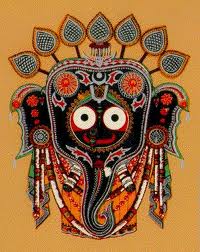
Snan Yatra Further Explained

Snan
Yatra in India and the significance of a bathing ceremony:
Snan Yatra &
Hati Vesha Utsav:
The Snan yatra bathing ceremony
of Lord Jagannath has become one of the most popular festivals on the Iskcon
calendar over the years since His Divine Grace Srila A.C. Bhaktivedanta
Swami Prabhupad introduced it to the world outside of India. Traditionally
this festival has been going on since the time of the carving of the 'Dharu-brahman'
Deities of Lord Jagannath, Lord Balaram, and Lady Subhadra in Sri Purushottam
Kshetra (Jagannath Puri) thousands of years ago, commemorating Their sacred
appearance for Their devotees - primarily the saintly King Maharaj Indradyumna.
Many of you would know
that after the bathing ceremony the Lord catches a transcendental chill,
are fed sweet foods and drinks to break Their fever, and then retires for
Their 'Anavasara kala' - recuperation period. In Jagannath Puri where the
Deities are painted with natural mineral paints, after the bathing ceremony
the paints have a tendency to run and the Deities would be not viewable
to the general public. So to allow the devotees to partake further in the
Lord's pastimes, They made a special arrangement with one 'brahmin' who
came to visit to take 'darshan' at this time.
Lord Sri Krishna, Jagannath is
the Lord of the Universe and so in essence is the original creator of everything,
nothing exists without Him. In one sense then everything is Him, at least
coming from Him. Just as in the creation of a by-product from an original
source the by-product has it’s existence by association with the original
object. Shastra gives the example of milk being transformed into yogurt
for a functionary analogy of Krishna being like the original source (milk
in this case) and lord Shiva being like yogurt, having come in contact
with a culture for his functionary activities in the material world. The
milk therefore in one sense created yogurt, but that yogurt can never again
become milk. Therefore it, although one in origin, it is different, becoming
secondary or mutated potency and therefore lessor in potency and function.
Sripad Shankaracarya taught
a very dangerous philosophy called pancopasika (païcopäsanä
– Chaitanya Chairitamrta Adi-lila 7:151. Purport; Madhya-lila 9:360. purport),
which wrongly inferred that the Lord and His primary creation, and the
predominating Deities of it were equal in potency to Him. He said that
Lord Vishnu, Ganesh, Shiva, Surya, Laxmi (Durga, Kali, Saraswati) were/are
equal which to us, and to Lord Vishnu is to be considered as a grave offense
(çivasya çré-viñëor ya iha guëa-nämädi-sakalaà
/ dhiyä bhinnaà paçyet sa khalu hari-nämähita-karaù.
– Padma Purana.)
In various places it is phrased slightly different ways; (2) to consider the Lord and the demigods to be on the same level or to think that there are many gods (A.C. Bhaktivedanta Swami Prabhupada. Sri Chaitanya Charitamrta Adi-lila 7:73., purport.) (b) to consider the name of Lord Çiva or any other demigod to be equally as powerful as the holy name of the Supreme Personality of Godhead (no one is equal to the Supreme Personality of Godhead, nor is anyone superior to Him)(A.C. Bhaktivedanta swami Prabhupada. SB 7:5:23-24. Purport.) ”The second offense is to see the holy names of the Lord in terms of worldly distinction. The Lord is the proprietor of all the universes, and therefore He may be known in different places by different names, but that does not in any way qualify the fullness of the Lord. Any nomenclature which is meant for the Supreme Lord is as holy as the others because they are all meant for the Lord. Such holy names are as powerful as the Lord, and there is no bar for anyone in any part of the creation to chant and glorify the Lord by the particular name of the Lord as it is locally understood. They are all auspicious, and one should not distinguish such names of the Lord as material commodities.”(A.C. Bhaktivedanta Swami Prabhupada. Srimad bhagavatam 2:1:11. Purport.)
sthävara-jaìgama dekhe,
nä dekhe tära mürti
sarvatra haya nija iñöa-deva-sphürti
“A Vaiñëava never sees the material form of anything, moving or nonmoving. Rather, everywhere he looks he sees the energy of the Supreme Personality of Godhead, and immediately he remembers the transcendental form of the Lord.”
This wonderfully merciful and
enlivening story of the Lord knowing the heart of His devotee, and personally
bestowing His mercy upon him has nothing what so ever with that deviant
philosophy.
The story goes that this 'brahmin'
was a devotee of Lord Jagannath, but for some reason expected to see the
elephant-headed deva, Ganesh, in the temple. The 'brahmin' was somewhat
disappointed seeing the deva / demigod not there, and that Lord Jagannath
had been bathed already and that They were looking a bit 'off colour' with
Their mineral paint colours running. In many ways the hearts’ desire of
that devotee were unfulfilled. Then that night, knowing his heart, the
Lord appeared to the devotee in a dream and told him to go back to the
temple and he would not be disappointed. Rather all his desires would be
fulfilled by worshipping Lord Jagannath and not by separatedly worshipping
any deva (Bhagavad Gita 9:23.).
The all merciful Lord then appeared to his devotee; Lord Jagannath and Lord Balaram assumed the appearance of beautifully decorated elephants, while Lady Subhadra decorated Herself as a Lotus flower. From that time on they began the Hati Vesha (Elephant Mask) festival. Consequently some call it the Hati-vesh festival, some the Ganesh-vesh festival. Both are correct – the Lord assumed a special form to satisfy His devotee, just as in other cultures we hear stories of the Lord appearing to Moses in the form of a Burning Bush, or to Mohammed in the form of sound, or as with Jagannath in the form of the Dharu-brahman logs that washed up upon the ocean shore to be carried by the sabara Virabhadra, and fashioned by the architect of the devas Vishvakarma into the wonderful forms of Sriyuts Jagannath, Baladeva and Subhadra maharani we see before us.
Formerly when we were in Mayapur
we had the rare opportunity to discuss through some local devotees (Jananirvas
and Pakajanagrhi prabhus) with 'pujaris' from Jagannath Puri who were helping
to authenticate Iskcon's 'seva' to the Lord at the Jagannath temple in
Mayapur. They described to me the festival, and how to execute it. Since
then we began that festival in Melbourne, Australia where the festival
is still an escalating favourite with all of the congregation of devotees.
In essence the festival
begins with Their Lordships coming to the Snan-Vedi. At this time everyone
there gets the great blessing of being able to render the service of bathing
the Lord in nectarean natural bathing substances. After that the Deities
return to the altar to be cleaned off, where They are tended by Their 'sevaks'.
The Deities are then dressed in their 'Hati Veshes' (Elephant Masks) and
offered a wonderful myriad of sweets and sticky buns, cakes, and local
delicacies - as all elephants, and especially These Transcendental Ones,
love. The curtains are again opened leaving the food offerings of love
for all to see before the Lord. The 'Arati' ceremony is then performed,
and according to the Jagannath pujaris, traditionally it is accepted that
the Lord bestows all benedictions and blessings upon those fortunate enough
to be there to see Them there in Their Elephant masks. After the 'Arati'
the Deities retire to Their 'Anavasara' rest rooms
to 'restore the colour to Their cheeks', where the Lord will be served
in private intimacy for the next couple of weeks up to the 'netrotsava'
or 'nava yauvanotsava' - first restoration 'darshan'.
The abundance of offerings
are then distributed for a small donation to all the eager devotees who
wait to savour the culinary blessings of the Lord too.
Their Lordships now have
their very own Hati Veshes so that everyone may participate in this transcendental
festival. We hope to see you all there.
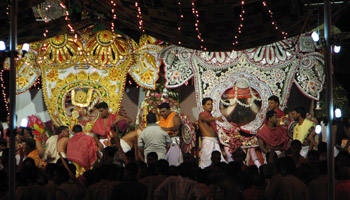
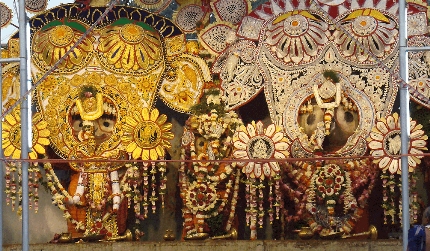
Hati vesha darshan in Jagannath Puri 2007
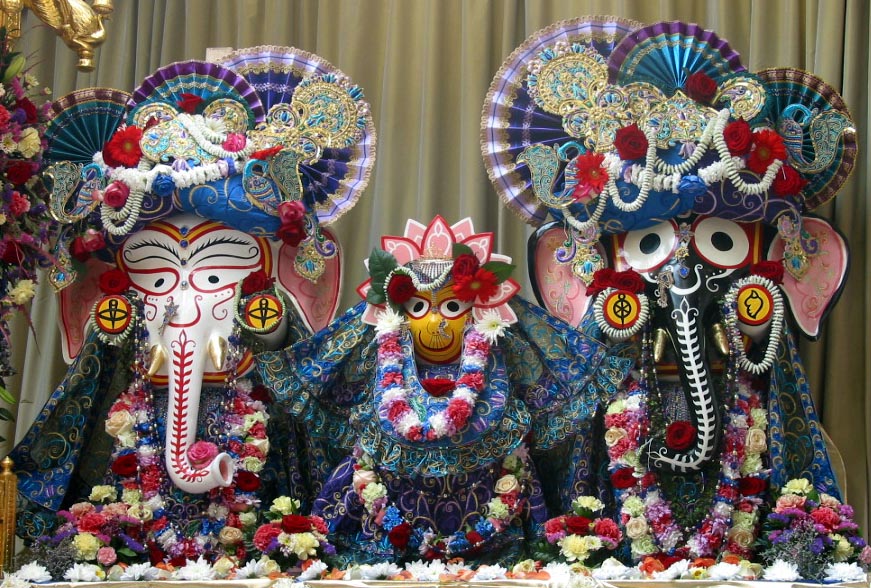
Hati vesha as worn by Jagannath Baladev Subhadra in Soho st London
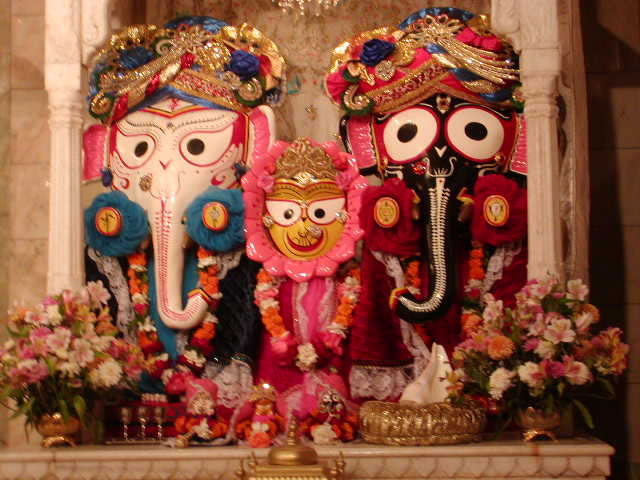
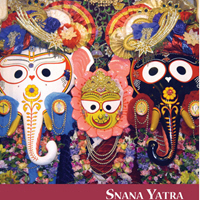
Hati vesh Melbourne, Australia
Hati vesh darshan @ Iskcon Mira Road, Mumbai
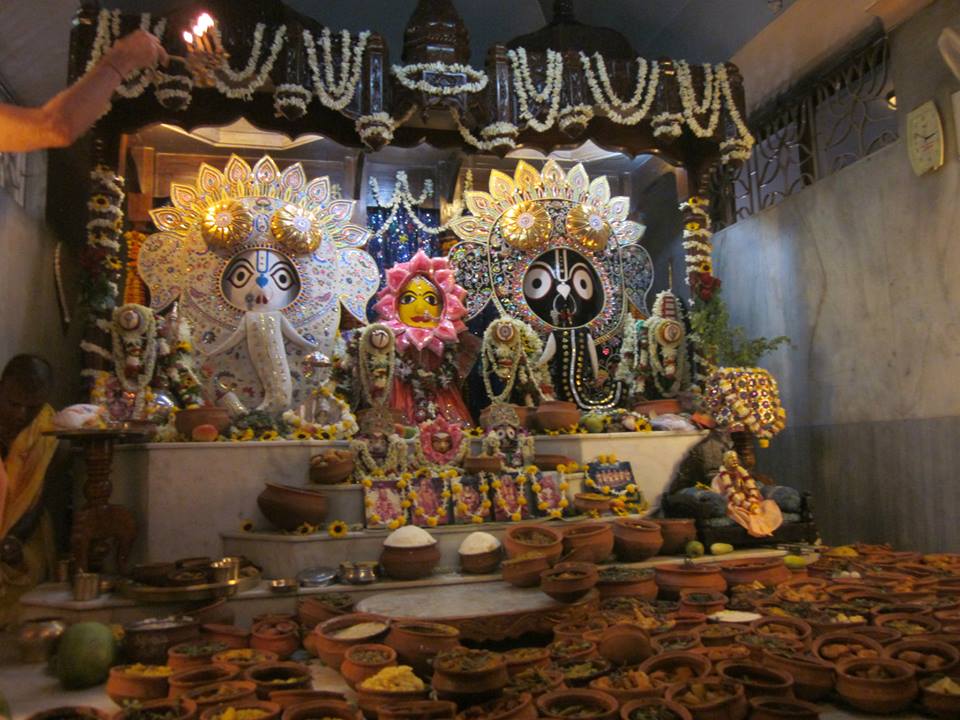
Jagannath mandir, Rajapur, Mayapur west Bengal
The scenario is like this;
First comes Chandan Yatra - the weather is so hot by now that one constantly sweats and sweats. The only thing to really provide one with a cooling solution is to cover oneself with sandal wood pulp. As the sandal wood dries it protects one from the heat, and any sweat that does come out moistens the sandalwood which when touched by a breeze gives amazing relief from the heat.
Then comes Snan Yatra. By now the heat is stifling, all that anyone
wants to do is submerge themselves in the waters of the Yamuna, or the
Bay of Bengal in Jagannath Puri. The only solace is water - and so the
Supreme enjoyer also enacts this wonderful of bathing with His devotees.
If anyone has the great good fortune to go to Vrindavan during
Snan Yatra it is the most transcendental time - for me at least it's the
nicest time of year. At every temple, in all of Vrindavan, every Deity
comes into festive bathing mood. It's the most amazing thing, to go from
temple to temple enjoying seeing and participating in the Lord's transcendental
festival of Snan Yatra.
At the Sri Radha Raman temple there is the most spectacular festival
( ask who has been there - during snan yatra?) The Deity of
Radha Ramanji is brought to the front of the pitha/altar - first there's
a spectacular arati for Him - followed by all manner of offerings - then
the Lord is sprayed with water from two shower-like sprays one either side
of Him. Under the sprays are coloured lights which tastefully go on and
off and different colours while the Lord stands there playing on His flute.
The Radha Raman temple is so designed that the devotees have
built in a sprinkler system all round the top of the wall, and even on
the fans. After the Lord takes His bath, all the devotees take their bath
- as the sprinkler system is turned on. And actually proving the practical
nature of these transcendental festivals it is so nice and refreshing.
The Lord's festivals go on as the weather increases in it's heat and humidity. The Lord then goes out on His Rath chariot under a canopy protected from the rain, and blistering sun that alternate during the journey on Rathyatra day.
Then as the humidity increases, raining most days, muggy like anything, sometimes 98% humidity is recorded for days in Vrindavan, and the temperature is 35+ the last thing that you want is water. The air is thick with water, and there's not a breeze to be found - so the Lord then comes to His Jhulan swing, and enjoys His transcendental rasa of being swung by His loving devotees.
The essence is that we at these times give pleasure to the Lord, by providing Him with the service that He requires to keep cool. By that service the Lord blesses us with love, and remembrance for Him.
Just like today we're observing this Snan yatra. Everyone will get the
chance to come forward, after purifying your hands, and assist in bathing
the transcendental form of Lord Jagannath, Baladeva, and Lady Subhadra.
Afterwards the Deities will go back into the Deity room momentarily
to get cleaned up, and dried. Then following in the tradition of Jagannath
Puri we'll offer the Lord a feast of sweetmeats, for the Lord to enjoy
in His form of the Hati Vesha.
The festival begins with Their Lordships coming to the Snan-Vedi. At this time everyone here gets the great blessing of being able to render the service of bathing the Lord in nectarean natural bathing substances.
But don't go afterwards, take a little prasadam, and then come back because according to the tradition in Puri Lord Jagannath and His Transcendental Brother and Sister pour profuse blessing upon everyone, EVERYONE, who come to see Them dressed in Their Hati Veshes.
So please have a great time, and help us give a cooling pleasure to Lord Jagannath, Baladev and Lady Subhadra.
Kirtan begins: Jaya Jagannath
Deities come to the Snan Vedi:
Sri Sriyuts Jagannath, Baladeva, Srimati Subhadra Maharani Snan-yatra & Hati Vesha Utsav ki jaya.
During these Festivals after Snana Yatra Lord Jagannath become sick and suffers from fever. He is therefore moved to his private stay, there He is offered drugs which are prepared by the fruit juice. The Dayita (servants of Lord Jagannath) take care of Lord Jagannath. They sleep and stay there with the Deity. The word ANAVASARA is used when Lord Jagannath is not seen in the temple.
NIBHRITA FESTIVAL:
The fifteen days period of Resting and Renovation is called NIBRITHA.
Honouring the isolation of his wife Goddess Laxmi, Lord Jagannath lives
there in privacy enjoying SVAKIYA RASA. Then by taking her (Goddess Laxmi)
permission Lord Jagannath come out for His Rathayatra.
ANGA-RAGA OR NAVA YAVANA FESTIVAL:
These Festivals are held for the purpose of renovation of the Lord
Jagannath body. After being washed the body of Lord Jagannath needs repainting,
This work is done by the DAITYAS, which takes two weeks to complete. Then
the Lord Jagannath Deities is fully restored to youth (NAVA YAVANA).
NETROTSAVA:
This ceremony is performed in the inner shrine where the Deities are
placed in semi-horizontal position. They have been fully painted, except
their eyes. In this ceremony the eyes of the Deities are painted by their
respected Pujaries and the Puja (worship) is started in the temple. The
Deities are still in the same position.
After completing the above said ceremonies the Deities are taken out from the temple and placed in their respective chariots on the Rathayatra day.
The procession of the Deities from the temple to the chariot is the most colorful aspect of the Rathayatra. The Chariots are brought and kept at front of the Simha Dwara, facing north side before Rathayatra begins. In a traditional ceremonial manner first Sudarshana is brought from the temple and put on to the Chariot of Lady Subhadra, followed by Balabhadra first as is elder in the family placed in his chariot, then followed Lady Subhadra and Lord Jagannath are placed in their respective chariots.
While bringing the Deities of Balabhadra and Lord Jagannath out of the temple they are made to swing forward and backward in a manner called "PAHANDI". As the Deities are extremely heavy they need many strong men to move them. Each Deity is provided with thick soften ropes around their body. By taking assistance from the Pujaries who holds the ropes, the Dayitas(Lord Jagannath servants) move the Deities. As the main Deities arrive on their respective chariots ,the small Deities of Lord Rama and Krishna are placed on the Balabhadra chariot and Madanmohan Deity is placed on Lord Jagannath chariot. All Deities are then refreshed and offered fresh garlands. At this time in a Palanquin the king of Jagannath Puri arrives and sweeps the street in front of the chariots with a golden handled Whisk broom-stick and sprinkles the ground with fragrant waters.
After all this Rituals completed the Rathayatra begins with the Balabhadra chariot going first as he is elder. Then follows chariot of Subhadra and then follows chariot of Lord Jagannath. The chariots of Lady Subhadra and Balabhadra reach directly the Gundicha temple, where as the chariot of Lord Jagannath stops at his Mausima (Aunt's) Goddess Ardhamsini temple. Here the Lord is offered with Poda Pitha(fried cheese cake). Again the chariot of Lord Jagannath proceeds towards the Gundicha Temple. However the Rath (chariot) of the Lord Jagannath usually reaches the Gundicha Temple next day. After reaching the Gundicha Temple the Deities take rest on their chariots for another day ,then they are taken into the sanctum of the Gundicha Temple. while staying in the Gundicha temple for seven days the Deities receive all the routine Rituals same as they used to receive in the main temple.
On the 10th day, fortnight of Ashada the Deities are brought back on to their respective Chariots and the Rath is pulled back to the main temple, this is known as BAHUDA YATRA. While returning to the main temple Lord Jagannath stops again at His "Mausima" Goddess Ardhamsini temple and receives BOGH(Poda Pitha). He then proceeds towards the King's palace where he has a meeting with Goddess Laxmi and continues his Yatra and the Rathayatra reaches to an end i.e.. to the Lord Jagannath Temple at night and spend their night in the Rath till Morning.
Next day in the morning on BADA EKADASI the Deities are Dressed in the SUNA VESHA(THE GOLDEN-DRESS), Arms and Feet which are made of pure gold are attached to the Deities, and are decorated by putting on them the Golden Ornaments and Golden Crowns. This day is considered to be the most auspicious day of the festival. The devotees makes Pradhakshina of the rath(chariot) by moving around the chariots. After a few hours the golden ornaments are removed from the Deities and brought back to the temple, As usual first comes Balabhadra then Subhadra and then Lord Jagannath in a traditional procession among huge assembly of thousands of devotes.
Lord Jagannath faces a tough time when he tries to enter into the temple, as Goddess Laxmi is angry with Lord Jagannath because he went to Rathayatra along with his Brother and Sister She also expresses her anger by going to the Gundicha Temple on 5th day of the festival. The DEVIDASIS (servants of Godess Laxmi) close the Simha Dwara and ultimately opens it again but closes the Jaya Vijaya Dwara, Hear songs comprising of dialogues exchanged between DEVIDASI and DAYITAS. Then Lord Jagannath tells to Goddess Laxmi if he is allowed to enter into the temple He will present her so many gifts, listening to this Goddess Laxmi allows Lord Jagannath to enter into the Temple. Thus Rathayatra is completed.
The following references to Snana-yatra appear in the Madhya-lila of
Sri
Caitanya-caritamrta:
Madhya 1.121
TRANSLATION
After collecting these books, Sri Caitanya Mahaprabhu returned to Jagannatha
Puri. At that time, the bathing ceremony of Jagannatha was taking place,
and
He saw it.
Madhya 1.122
TRANSLATION
When Jagannatha was absent from the temple, Caitanya Mahaprabhu, who
could
not see Him, felt separation and left Jagannatha Puri to go to a place
known
as Alalanatha.
PURPORT
Alalanatha is also known as Brahmagiri. This place is about fourteen
miles
from Jagannatha Puri and is also on the beach. There is a temple of
Jagannatha there. At the present moment a police station and post office
are
situated there because so many people come to see the temple.
The word anavasara is used when Sri Jagannathaji cannot be seen in
the
temple. After the bathing ceremony (snana-yatra), Lord Jagannatha apparently
becomes sick. He is therefore removed to His private apartment, where
no one
can see Him. Actually, during this period renovations are made on the
body
of the Jagannatha Deity. This is called nava-yauvana. During the Ratha-yatra
ceremony, Lord Jagannatha once again comes before the public. Thus
for
fifteen days after the bathing ceremony, Lord Jagannatha is not visible
to
any visitors.
>>> Ref. VedaBase => Madhya 1.121-122
Madhya 10.41
TRANSLATION
Sarvabhauma Bhattacarya first introduced Janardana, saying, "Here is
Janardana, servant of Lord Jagannatha. He renders service to the Lord
when
it is time to renovate His transcendental body."
PURPORT
During Anavasara, after the Snana-yatra ceremony, Lord Jagannatha is
absent
from the temple for fifteen days so He can be renovated. This occurs
annually. Janardana, who is here being introduced to Sri Caitanya
Mahaprabhu, was rendering this service at the time. The renovation
of Lord
Jagannatha is also known as Nava-yauvana, which indicates that the
Jagannatha Deity is being fully restored to youth.
>>> Ref. VedaBase => Madhya 10.41
Madhya 11.60
TRANSLATION
When the King asked the Bhattacarya when the bathing ceremony [Snana-yatra]
of Lord Jagannatha would take place, the Bhattacarya replied that there
were
only three days left before the ceremony.
Madhya 11.61
TRANSLATION
After thus encouraging the King, Sarvabhauma Bhattacarya returned home.
On
the day of Lord Jagannatha's bathing ceremony, Sri Caitanya Mahaprabhu
was
very happy at heart.
Madhya 11.62
TRANSLATION
Upon seeing the bathing ceremony of Lord Jagannatha, Sri Caitanya Mahaprabhu
became very happy. But when Lord Jagannatha retired after the ceremony,
Lord
Caitanya became very unhappy because He could not see Him.
PURPORT
After the bathing ceremony of Sri Jagannatha, which takes place just
a
fortnight before the Ratha-yatra ceremony, the body of the Lord Jagannatha
Deity is repainted, and this takes just about a fortnight to complete.
This
period is called Anavasara. There are many who visit the temple to
see Lord
Jagannatha regularly every day, and for them His retirement after the
bathing ceremony is unbearable. Sri Caitanya Mahaprabhu felt Lord
Jagannatha's absence from the temple very much.
Madhya 11.63
TRANSLATION
Due to separation from Lord Jagannatha, Sri Caitanya Mahaprabhu felt
the
same great anxiety the gopis feel in separation from Krsna. In this
condition He gave up all association and went to Alalanatha.
>>> Ref. VedaBase => Madhya 11.60-63
Madhya 13.8
TRANSLATION
The very strongly built dayitas [carriers of the Jagannatha Deity]
were as
powerful as drunken elephants. They manually carried Lord Jagannatha
from
the throne to the car.
PURPORT
The word dayita refers to one who has received the mercy of the Lord.
Lord
Jagannatha has a number of stalwart servants known as dayitas. These
servants do not come from very high-caste families (brahmanas, ksatriyas
or
vaisyas), but because they are engaged in the service of the Lord,
they have
been elevated to a respected position. Thus they are known as dayitas.
These
servants of Lord Jagannatha take care of the Lord from the day of the
Snana-yatra up to the time the Lord is carried from the throne to the
Ratha
car. In the Ksetra-mahatmya these dayitas are said to come from the
sabaras,
a caste that keeps and sells pigs. However, among the dayitas there
are also
many who come from the brahmana caste. Those dayitas coming from the
brahmana families are called dayita-patis, or leaders of the dayitas.
The
dayita-patis offer food such as sweetmeats to Lord Jagannatha during
the
anavasara, the resting period after Snana-yatra. They also make the
early-morning offering of sweetmeats daily. It is said that during
the
anavasara Lord Jagannatha suffers from fever and that the dayita-patis
offer
Him an infusion of drugs represented by fruit juice. It is said that
in the
beginning Lord Jagannatha was worshiped by the sabaras and was known
as the
Deity Nila Madhava. Later, when the Deity was established in the temple,
the
Lord became known as Jagannatha. Because the Deities were taken from
the
sabaras, all the sabara devotees were elevated to the position of dayitas.
>>> Ref. VedaBase => Madhya 13.8